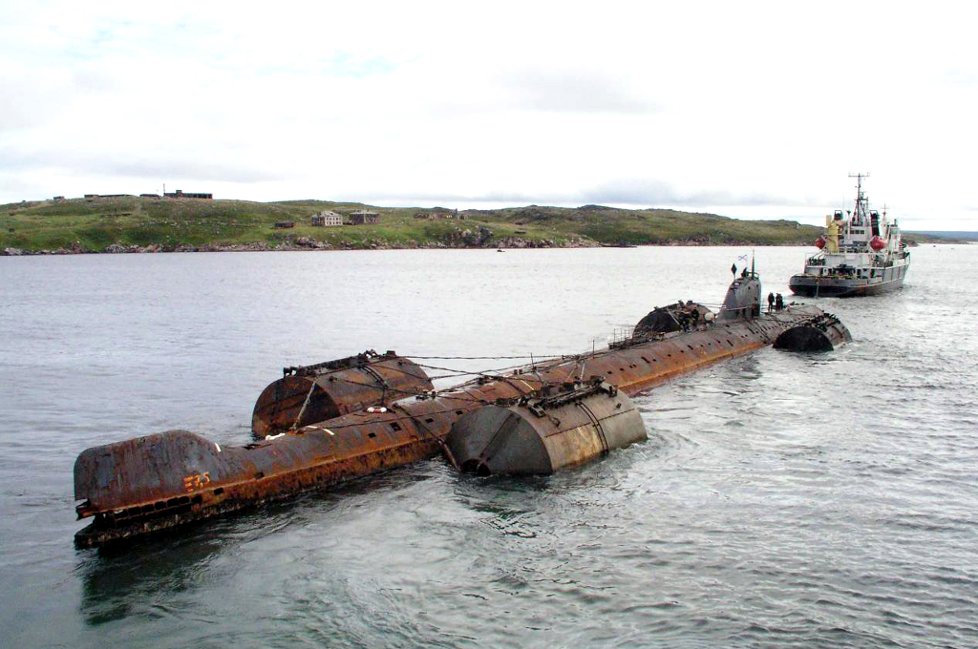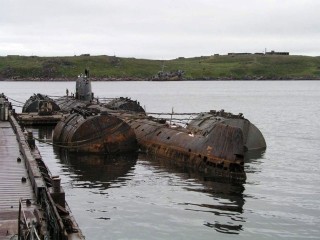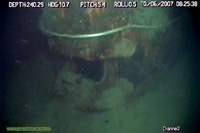
The system built to manage Russia’s nuclear legacy is crumbling, our new report shows
Our op-ed originally appeared in The Moscow Times. For more than three decades, Russia has been burdened with the remains of the Soviet ...
News

Publish date: September 1, 2014
News
A long planned Russian-Norwegian joint research trip to examine the remains of the derelict K-159 nuclear submarine – which sunk under tow to a Murmansk area shipyard in August 2003 – is finally underway after several mechanical delays, Norwegian radiation officials have confirmed.
The K-159 submarine, which was under tow by tugboat in rough waters from the Gremikha Russian naval installation to Polyarny, plummeted to the bottom of the Barents Sea when the tow line snapped.
Ingar Amundsen, head of section the Norwegian Radiation Protection Authority (NRPA) told Bellona in earlier interviews about the mission that it was expected to be at sea for three weeks conducting radiological studies of the deep wreckage and return sometime in early this month.
When it sank, the K-159 drowned nine Russian sailors who were aboard to plug leaks, and carried 800 kilograms of spent uranium fuel still in its two pressurized water reactors to a depth of 246 meters, where it has laid for 11 years 130 kilometers from Norway, despite several promises from Russia to raise it.

Though the Russian side has insisted the vessels poses no radiological hazards, it is still considered by the Norwegian Radiation Protection Authority (NRPA) to be one of the most radioactively dangerous objects on the bottom of the Arctic seas.
One piece of nuclear trash at sea
Indeed, an accumulation of reports from Russia to the NRPA reveal the Soviet and Russian Navies littered the Kara Sea with all manner of nuclear and radioactive waste over several dozen years, stopping in the early 1990s.
According to NRPA, a catalogue of Russian nuclear waste in the Kara Sea released in 2012 includes 19 ships containing radioactive waste; 14 nuclear reactors, including five that still contain spent nuclear fuel; 735 other pieces of radioactively contaminated heavy machinery; 17,000 containers of radioactive waste, and the K-27 nuclear submarine.
Figuring out whether the sub is leaking radioactivity
Unconfirmed reports about possible radioactive leakage from the K-159 have lent urgency to the present joint research mission to be conducted aboard the Ivan Petrov scientific vessel, which was initially scheduled to depart Arkangelsk in late June, but finally set sail after propeller repairs on August 22, an NRPA said in a statement.
The specter of possible radioactive leaks from the K-159, which is situated at the mouth of the Murmansk Fjord in some of the Arctic’s most fertile fishing grounds, was raised by a film passed anonymously by a Moscow military source to the French-German TV channel ARTE, the Barents Observer new portal reported.
The film – which has been removed from YouTube for copyright infringement – was taken four years after the sub’s sinking by a Russian-British expedition, and the anonymous source told the network he was concerned about rising radiation levels surrounding the sub, though he mentioned no levels.
The footage, as described by the Barents Observer last year, shows a large hole in the bow of the submarine. an open hatch in the conning tower, and cables visible through holes in the rusted hulk’s hull. There is also footage of a submersible robot taking radiation measurements through air pressure ports on the deck of the vessel. It also shows schools of fish darting in and out of the wreckage.
Norway’s fishing industry jeopardized by speculation
“The submarine was in very bad condition when it sank, and there have been unconfirmed rumors that the Russians have measured radioactivity at the wreck,” Nils Bøhmer, Bellona’s general director and nuclear physicists, said. “It is therefore important that Norwegian authorities now make their own measurements,” noting that even hints of radiation could harm Norway’s fishing industry.
NRPA director Per Strand said one of the primary reasons for the current expedition is to see whether there’s any credence to the rumors.
“The submarine lies very close to Norway and is a potential source of pollution,” he said in the NRPA statement. “This expedition aims at getting updated information on the environmental situation in the area. In this way we can avoid speculations about radioactive contamination of the fishery resources in the Barents Sea.”
Environmental assessment needed to raise the sub
Amundsen told Bellona that NRPA also hopes to make some assessment about how to raise the K-159 – but added that any such effort would be Russia’s responsibility.
“What we believe is important is to make an environmental impact assessment of a potential raising operation,” Amundsen told Bellona. “ “The submarine contains a great deal of radioactive material and sooner or later it will leak, but we need to get a good picture of where things are at current in order to make an in depth environmental impact study of such an idea.”

Making determinations on what kind of radiological hazard the vessel presents, said Amundsen, will be based on measuring sediment and biota samples to determine whether there has been any rise in contamination since it was last measured.
Bellona’s Bøhmer is hoping the expedition reveals the information needed to determine if the wreck needs to be raised – and how it can be done safely and, hopefully, with international cooperation.
“The ongoing expedition will hopefully give us more information on the status of the contamination from K-159 and thus give an indication on how much time we have before the situation gets critical,” he said. “It is also important to start the risk assessment of the lifting operation so that we know if it is possible to lift K-159 in a safe way,” he added, continuing: “The responsibility for the risk assessment and the lifting would be the Russian government’s, but it should be stressed that the international community should put forward technical experience, and if needed also economic assistance to the lifting of the K-159.”
Hilde Elise Heldal, the head of the expedition, told the Barents Observer that scientists from NRPA, Norway’s Institute of Marine Research, and the Center for Environmental Radioactivity at the Norwegian University of Life Sciences are aboard the Ivan Petrov for the investigative expedition.
Report on last Russian-Norwegian mission expected soon
The last joint mission between Russian and Norwegian scientists was in 2012, when 16 Russian and Norwegian scientists inspected the condition of the K-27 nuclear submarine, which was scuttled as nuclear waste in a shallow 50 meters of Stepovogo Bay on the Novaya Zemlya Archipelago in 1981. No dangerous radioactive emissions where found on that mission.
The K-27’s reactor contains significant amounts of highly enriched uranium and it’s thought that efforts to lift the vessel could restart the reactor and cause an uncontrolled reaction, NRPA director Strand told Bellona in 2012.
Strand recently told the Nordlys.no news portal that his agency would be publishing an international report on the 2012 expedition next month.
For the current mission to the K-159, Russia has sent scientists from the Research and Production Association Typhoon, the Kurchatov Institute and the State Scientific Centre Yuzhmorgeologiya, said the portal.
They are accompanied by observers from Russia’s Ministry of Defense and the International Atomic Energy Agency, according to a release (in Russian) from RosGidroMet, Russia’s Hydrometerology and Environmental Monitoring Agency.
“The scope of spent nuclear fuel, reactors and radioactive waste on the seabed in the Kara Sea and the Russian part of the Barents Sea is large,” Strand said in his statement.

Our op-ed originally appeared in The Moscow Times. For more than three decades, Russia has been burdened with the remains of the Soviet ...

The United Nation’s COP30 global climate negotiations in Belém, Brazil ended this weekend with a watered-down resolution that failed to halt deforest...

For more than a week now — beginning September 23 — the Zaporizhzhia Nuclear Power Plant (ZNPP) has remained disconnected from Ukraine’s national pow...

Bellona has taken part in preparing the The World Nuclear Industry Status Report 2025 and will participate in the report’s global launch in Rome on September 22nd.